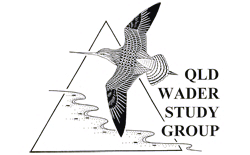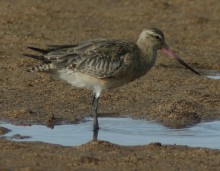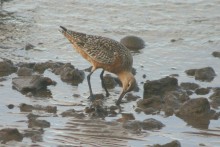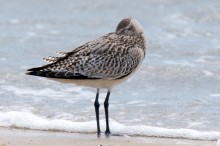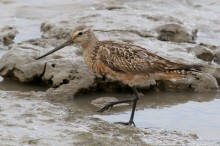Limosa lapponica
Subspecies
L. l. lapponica
L. l. baueri (This is the sub-species predominantly found in eastern Australia)
L. l. menzbieri (This is the sub-species predominantly found in western Australia)
Other Names
Barred-rumped Godwit, Pacific Ocean Godwit, Southern Godwit, Small Godwit, Eastern Bar-tailed Godwit, Barwit.
Identification
The Bar-tailed Godwit is a large streaked brown bird, with long legs and a long slightly upturned bicoloured bill. It is seen on the mudflats in groups feeding by pushing its bill deep into the mud.
Plumage
Non-breeding: This plumage is grey-brown on the head, neck and upperparts. There is a dark centre and lighter edge to the feather giving a slightly streaked look. The underparts are pale buff. The bill is bi-coloured with pink at the base and blending to black at the tip. The supercilium is white and with the dark eye-stripe giving rise to an obvious feature for identification. The legs and feet are dark grey.
Breeding:
The adults take on a rich chestnut-red plumage over the neck, shoulders and underparts. The upperparts are red-brown with a darker centre to the feathers giving a streaked look. The black barring on the white of the rump seems to stand out in the breeding plumage. The bill is bicoloured with pink at the base and blending to black at the tip; the female has a longer bill.
Juvenile: Similar to adult non-breeding plumage, though seem to have a more strongly streak appearance.
Distribution
Found all around the Australian coast where there is suitable habitat. They like large intertidal flats, estuaries, inlets, coastal lagoons plus some man-made wetland areas.
Migratory habits
Bar-tailed Godwits leave our shores during March and April for their breeding grounds in eastern Siberia and Alaska. They return to us in August and September. Some birds over winter in Australia.
Breeding
Breeds in the high Arctic from northern Europe, through Asia into Alaska. It usually reaches the breeding grounds in May.
Status
Very common wader found a round Australian coast. There may be over 185,000 birds during the summer months.
East Asian-Australasian Flyway Population: 325,000
Confusing Species
Black-tailed Godwit: Very similar to the Bar-tailed Godwit in non-breeding plumage. The plumage is less streaked. The bicoloured bill is straight. Appears to be of a slighter build and tends to be feeding at high tide whilst the Bar-tailed Godwits rest.
Asian Dowitcher: This is a very rare visitor to Australia, but it is worth looking out for in a flock of Bar-tails. It is slightly smaller with a straight black bill. It stands with its bill pointing downwards like a snipe.
Images
| Bar Tailed Godwit – Fresh Juvenile:- Note the fresh buff scalloping on the tertials and covert feathers that show this is a newly arrived juvenile with fresh feathers. | |
| Bar-tailed Godwit – Worn Juvenile:- Unlike the previous image note how the buff scalloping has started to wear away from most of the feathers which over time starts making the bird look very plain, this can make them very difficult to tell from adults late in the Summer season unless they are in the hand | |
| Bar tailed Godwit – Adult in non breeding plumage:- Note the plain tertials and covert feathers which lack the scalloping that is seen in the juvenile photographs above. | |
| Bar Tailed Godwit – Adult in Breeding plumage, this bird is in full breeding plumage but not all birds are in full plumage when they leave Australia and may have varying amounts of summer plumage when they migrate. | |
| Bar Tailed Godwit – Adult in partial breeding plumage |
